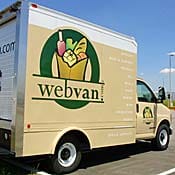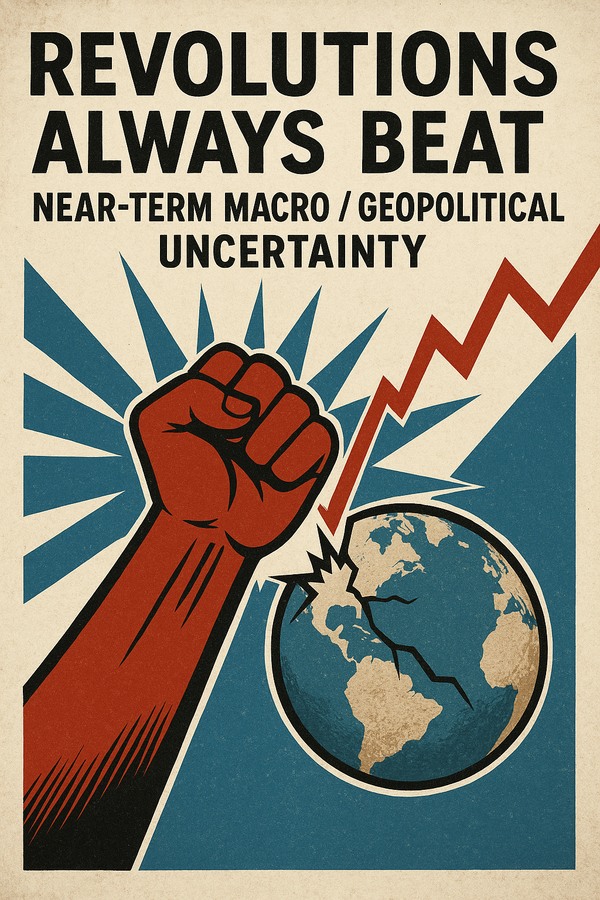The Five Dumbest VC Deals Getting Done Right Now

If we’re going back to Web Boom 1.0 levels, it’s important to try and game out how the cycle is going to go.
Some of the companies from Web Boom 1.0 are still around in wounded form. And some are booming: Amazon just reported a dynamite quarter.
So far Web Boom 2.0 been lots of good ideas funded with small amounts by relatively small players. We’ll get to varying degrees of the bubble when those three elements, quality of idea, notional amount, type of investor, change.
And right now I’m starting to see dumb ideas funded with bigger amounts but still by the traditional VC shops. I’m also seeing good ideas funded with bigger amounts, which is another way to get to a dumb deal.
Much of what I’m talking about boils down to expectations. The pressure now to succeed right out of the gate and drive traffic or clicks or revenue or user growth is enormous. And that pressure is only multiplied every time each successive round of funding gets larger and larger.
I don’t know if any company is going to be allowed to grow as organically and messily as Facebook and Twitter did.
One of the biggest busts of the Web 1.0 illustrates this perfectly. WebVan started in the late 90s to deliver fresh groceries to customers within 30 minutes. To borrow Web 2.0 parlance, it was Dominos for groceries. It’s a pretty cool and disruptive idea, and the technology might not have been quite ready, but the real thing that killed WebVan was the reflexive cycle of investor expectations—spending that VC cash to ‘grow’ as quickly as it could. Even the future TBTF crowd was in on WebVan–then Goldman Sachs CEO Hank Paulson was one of their most prominent backers. And here’s how WebVan responded to all that pressure. Per Wikipedia via CNET:
While Webvan was popular, the money spent on infrastructure far exceeded sales growth, and the company eventually ran out of money. For example: Webvan placed a $1 billion (USD) order with engineering company Bechtel to build its warehouses, bought a fleet of delivery trucks, purchased 30 Sun MicrosystemsEnterprise 4500 servers, dozens of Compaq ProLiant computers and several Cisco Systems model 7513 and 7507 routers, as well as more than 80 21-inchViewSonic color monitors, and at least 115 Herman Miller Aeron chairs (at over $800 each).

By comparison another little project Bechtel was involved in, the Hoover dam, cost $680 million in today’s money.
So here are five of the dumbest deals getting done right now. They’re dumb because the money has run ahead of the execution or the idea itself just isn’t that great or some combination of the two. These are all deals that are currently alive, I’ve excluded ones like HiGear, a peer-to-peer luxury car sharing service that raised $1.2 million only to shut down when a criminal ring targeted them and stole a bunch of high end rides (I guess you never think you’re in a Nicholas Cage’s movie until it’s too late).
The last part of my Bubble Equation, size of investor, will be the real canary in the coal mine. Even though seed funds and VC funds have jumped up an order of magnitude they are still tiny by comparison to the mutual fund industry. When Franklin Resources and T. Rowe start investing in apps and augmented reality, that’s when you really want to bail out.
1. Color

logo v 1.0

logo v 2.0
The easiest one and the one you likely know about. Yes they spent $350,000 buying Color.com and $150,000 on Colour.com (hilariously Andrew Wicklander spent $24.37 for mycolorapp.com and mycolourapp.com and asked if the extra $499,975.63 was worth it).
But the real cardinal sin was one of the worst launches in modern history. That’s no exaggeration, Apollo 13 got off to a better start. After a million people downloaded color from the App store, barely 10% of those were using it when it was pulled. Try asking someone who did download it what Color was and they’ll tell you it had something to do with sharing pictures and your location, but they can’t be sure because it was really buggy.
For now Color is back in private beta, doing something with broadcasting something about Facebook. All of this would be fine, disruption is supposed to be a messy process with setbacks, if Color hadn’t raised so much money. $41 million from Bain and Sequoia Capital, who were hoping for another homerun like the Color team had when they sold Lala to Apple. They should have just bought two shares of the Mets for that much and been content with some RBI’s.
2. The Melt

Picture this: in the last couple years you’ve built up Flip, the video camera company and convinced Cisco to buy it for $590 million only to see them shut it down. You’re next logical move?
That’s exactly right! Starting a grilled cheese restaurant and raising $15 million from a bunch of big tech investors.
Now I love me some grilled cheese and the McDonald’s and Chipotle’s of the world started somewhere but Color me skeptical about The Melt’s projection of 500 grilled cheese joints across our fair country in the next few years. And at $10 bucks a pop—that’s twice Subway for those not in the know— it’s definitely not cheap far.. Plus the reviews have been more than a little mixed.
So this is a cool idea, grilled cheese plus iphone ordering and QR codes to speed the whole thing up, and I applaud them for taking on the casual food industry. But this is the exact kind of deal that if it fails in retrospect will look totally obviously dumb. Think Pets.com with cheese.
3. HouseParty.com

Here’s a Techcrunch article about HouseParty.com. See how many bubble hits you can find (maybe that’s a good drinking game we should make an app for??):
HouseParty.com, a site that helps people throw brand-sponsored home parties, has raised$5.3 million in Series C funding in a round led by New York-based Acadia Woods Partners.
Partiers need to apply online, indicate what type of in-home event they’re planning and take charge in spreading the word to their friends and relatives. Once selected for a house party, they receive a package of products from sponsoring brands – ‘Party Packs’ have included food, baby toys, health and beauty products and action figures in the past.
The idea is for brands to get some relatively cheap word-of-mouth marketing by gathering people in real life (who do this in exchange for freebies) in the hope that the parties will spark conversations about the brand and, ultimately, turn the people who show up into customers or even advocates. People can also shop for party supplies on HouseParty.com. The company has raised about $8 million to date.
8 million dollars (Dr. Evil voice) to enable people to sell out their gatherings to corporations? That means the business is already worth nearly $50 million? That offends my sensibilities. And sometimes brands like Fresh Direct pay for people to party only to get flamed anyway. I understand the concept; this is measureable brand engagement vs throwing dollars at TV advertising. But with so much that can (and will) go wrong, I just can’t see this being anything but a small-time street-team level company.
I’ll leave you with the comment of one Emily J, who threw a ‘Nicolas Sparks Potluck Party’ :
The batteries that I had just charged for my camera died right when I started taking pictures, so I had to use my phone. I don’t have a fancy one, so I can’t email them to myself, and I can’t find the mini SD card adapter. Hopefully I can figure something out to get the photos on here.
4. Cherry.com

Cherry takes ‘there’s an app for that’ to the extreme. Here’s the company statement:
The carwash that comes to you: Park anywhere, check in online, and Cherry will wash your car right where you left it.
So far they have raised $5.2 million from the co-founder of Square, the Paypal mafia, and Shasta ventures. For a car washing app.
For $29 bucks you get the outside of your car wiped down with a solvent and you leave the inside unlocked for detailing. Cool enough, and maybe I’ll try it the next time I’m on the Left Coast. But raising $5.2 million to hire enough car washers to keep up with demand to fuel demand in new markets is exactly the kind of bubble math we saw a decade ago. So will Cherry disrupt traditional car washes? I don’t know. But that’s what it would have to do just to meet expectations.
5. Rover.com

Rover.com just raised $3.4 million to help you find someone to watch your dog (or to list your dog watching services). Let’s say the investors were pernicious and got the founder to give up 25% of the company (unlikely for a Series A, especially when the founder is a VC himself). So today, with little revenue, Rover.com is worth $12 million? That means the Series B can’t really be less than $6-8 million. Which means a year down the road, if the user sign up rate continues this thing is going to be valued at $50-60 million.
Want to know how VC’s justify those numbers without free cash flow? I’m going to give you a peek into the New Math: they look at addressable size of the pet market, look at how people find dog sitters now, normalize per hour rate over different markets, estimate hit ratio, project revenue five years out. That’s it.
Again, might work, potentially (don’t know if I’d let anyone I don’t know watch Lobo but that’s just me). But the expectations are already so high because of the amount raised that anything short of hitting triples and Rover.com will look like a disappointment. And that’s why this is a dumb deal (also: I have no idea how the heck they got Rover.com and why Land Rover didn’t already own it, but they do have a trademark).
Last point on this one, the lead investor is something called CrunchFund, the VC firm of unceremoniously dismissed TechCrunch founder Mike Arrington. Arianna might have done him a favor by edging him out into the investing world where he really wanted to be all along and I like some of the companies he’s invested in like Zaarly. But take a look at who the limited partners in CrunchFund are:
AOL, Accel Partners, Austin Ventures, Kleiner Perkins Caufield & Byers, Greylock Partners, Redpoint Ventures, Sequoia Capital, the founding partners of Andreessen Horowitz, each of the general partners of Benchmark Capital, Ron Conway, Yuri Milner, Brad Garlinghouse & Kevin Rose.
That doesn’t just read like a Who’s Who of Silicon Valley, that’s almost the entire list. So a dozen or so investors are committing a measly $20 million. For the VC funds that have invested, that means two fee layers before their investors make money. Why would they do that? Because Mike Arrington has access to great tech entrepreneurs, is a formidable presence in the tech world and they are terrified of being left out of deal flow.
When billionaires and billion dollar funds are willing to give a blogger millions, not to generate returns that will move the meter, but as as defensive pay-to-play strategy, that means we are indeed in the bubble that I prepared my readers for (see Why we are headed into a new stock market bubble and how to profit from it, among about 100 other articles I wrote telling you guys to get ready for this tech bubble, for example).
The bubble’s likely to get much bigger before it pops, and we will need to look for more outrageously ridiculous signs of tech bubble mania to get out of it before it pops.




